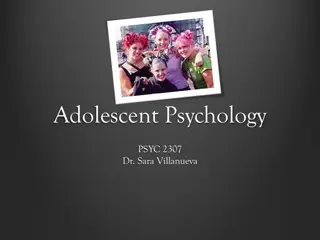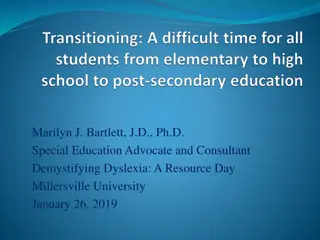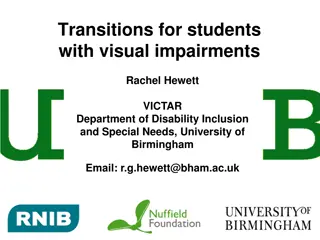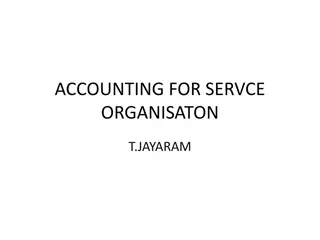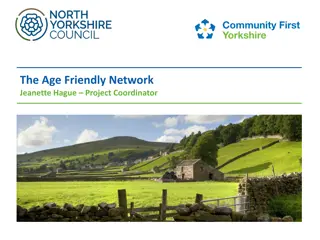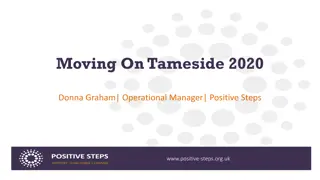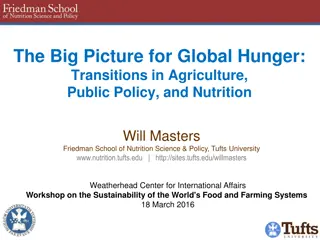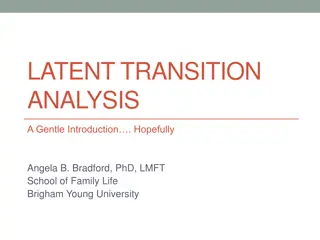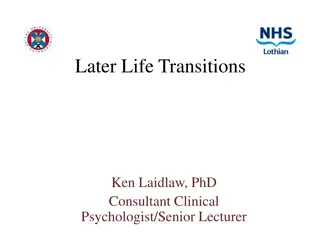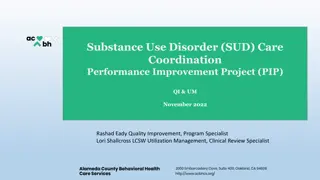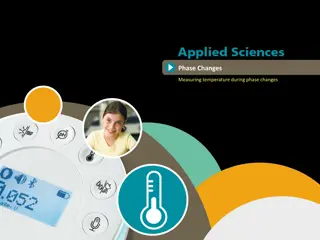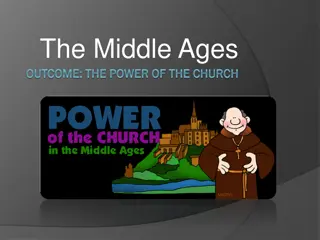Middle-Age Transitions and Generativity Concerns
Middle-aged adults experience transitions and conflicts according to Levinson's stages, focusing on generativity vs. stagnation. Research shows an increase in generativity concerns, while midlife crisis is not a universal experience. The period involves promoting well-being, contributing to society, and balancing past and future selves.
Uploaded on Sep 13, 2024 | 0 Views
Download Presentation

Please find below an Image/Link to download the presentation.
The content on the website is provided AS IS for your information and personal use only. It may not be sold, licensed, or shared on other websites without obtaining consent from the author. Download presentation by click this link. If you encounter any issues during the download, it is possible that the publisher has removed the file from their server.
E N D
Presentation Transcript
Generativity vs. Stagnation Middle-aged adults commit themselves to promoting the well-being of the younger generation and society as a whole Parental- helping children succeed in life Work- generating ideas and skills that are passed down Cultural- conserve, create, and promote valuable cultural assets Research shows an increase in concern about generativity
Aging, Generativity, and Self-Perceptions
Levinsons Seasons of a Mans Life Based on interviews of 40 middle aged men Novice Phase 20 s young adulthood period of testing a dream (image of the kind of life a man wants ) Major tasks are developing life structure Exploring possibilities Transition period at 28-33 where a man must determine his goals Focuses on family and career development
Levinson continued Becoming One s Own Man Transition to middle adulthood 40-45 Four conflicts Being young vs. being old Being destructive vs. being constructive Masculine vs. feminine Attached vs. separated 70-80% of men found this period tumultous
Levinsons Four Tasks of Middle Adulthood Find new ways of being both young and old Young Old Acknowledge past destructiveness, try to create products of value Destruction Creation Balance masculine and feminine parts of self Masculinity Femininity Balance involvement with external world and separateness from it Engagement Separateness
Possible Selves What one hopes or fears becoming Become fewer, more modest & concrete with age May become more time-oriented with age Compare to what you had planned
Midlife is not necessarily a crisis Several studies show that most adults do not experience a crisis One study found only 26% experienced a crisis and most attributed it to a life event Clark-Plaskie and Lachman found adults experience a peak in and power in middle age Costa, McCrae and Siegler in a sample of 2,000 found instability rarely increased in middle age Keyes and Ryff found autonomy, personal relations and ability to master their environment increased in middle age
Life-Events Approach Many aspects of a situation lead to the level of stress and ability to cope For example divorce may be less stressful now than 50 years ago Would the same apply to homosexuality?
Hassles and more common stressors More typical stressors may be as or more important as life events in determining stress and well being Concerns about weight and health Job stresses, to-do lists More common uplifts may also be important Marriage relationship Friendships Eating out
Personal Control One study suggests a sense of control declines throughout adulthood 80% at 25-39, 71% 40-59, 62% 60-75 Middle aged adults experience greater control over finances, work, and marriage but experience less control over sex life and children Middle aged adults are more likely to experience overload and women more likely to experience crossover stresses
Contexts Historical contexts (cohort effects) Social clocks timeline for when life s tasks are to be accomplished Gender contexts Development may differ for women Traditional theories may not focus enough on relationships, caring, and family roles Women have more interpersonal and males more self focused stressors Role shift was experienced by many women Some modern women experience midlife as a new prime
Cultural Contexts Not all cultures have a clear concept of midlife Midlife may have advantages for women in some nonindustrialized cultures Freedom form restrictions Become the matriarch Special statuses such as midwife, holy woman, matchmaker There may be differences even in industrialized societies
Stability and change Baltimore study Big five Costa and McCrae found stability but a metanalysis found both stability and instability Openness and extraversion change least Neuroticism tends to decrease, conscientiousness and agreeableness increase Berkeley Longitudinal studies Intellectual orientation, openness, and confidence were relatively stable Nurturing vs. hostility and self-control changed most George Vaillant s studies Some behaviors and traits in middle adulthood predict well-being in later life There is evidence of both stability and change across the lifespan and continuing personality development throughout adulthood
Close Relationships Love and Marriage Happy marriage is a major factor in well-being affectionate, companionate love increases in middle adulthood security, loyalty, and mutual emotional interest become more important as relationships mature even difficult marriages become better adjusted in middle adulthood married people express satisfaction For many there are more close relationships than at any other period
Divorce in middle adulthood couples may be alienated and avoidant marriages may have become empty -- lacking laughter, love, and interest in one another Midlifers adjust more easily than young adults Practical problem solving Effective coping strategies divorce may be more positive in some ways and more negative in others plus-- often more resources plus-- children less damaged and can cope better minus -- may be seen as personal failure or as betrayal
Empty Nest Empty nest syndrome decline in marital satisfaction after children leave the home for some a time for pursuit of other interests, career, and time for each other Refilling of the nest when young adult children return home to save money or recover from career set-back Permaparenting -- reluctance to let go of adult children Parents continue to provide emotional and/or financial support
Grandparenting Differing functions in families and in cultures or in situations Differences in style and interaction with grandchildren 3 styles formal fun-seeking distant
Changing Roles of Grandparents Divorce, adolescent pregnancy, and drug use have contributed to increasing numbers of grandparents assuming parental roles Emotionally and financial stress can be high but most grandparents express satisfaction Higher rates of depression, learning disabilities, and behavioral problems than children in two parent homes but similar to other children who have faced stressors (parental divorce, substance abuse, abuse, neglect ) Grandparent visitation issues in divorced and step- families Grandparents legal rights for visitation
Intergenerational relationships Keepers of meaning Middle-aged adults share experiences and transmit values to the younger generation As children become middle aged, they develop more positive perceptions of parents Family members maintain contact across generations Most common conflicts are interaction style, habits and lifestyle choices, child-rearing practices, and values
Caring for aging Parents Sandwich or Squeeze Generation -- responsibilities for adolescent and young adult children and for aging parents Fewer middle-aged adults are sandwiched than the media portrays When necessary, responsibilities are assumed by daughters (Hoyer & Roodin, 2003)
Caring for Parents 2 Highly stressful Average 20 hours/week Often starts suddenly, duration uncertain Work and costs increase Hard to witness parent s decline Support needed Culture and context also play a role
Work in Middle Adulthood More likely to peak in achievement and compensation Job demands and stress can also peak at this age Wide variety, some have stable careers while other make many changes Can be self-chosen changes or forced Unemployment can be especially challenging in middle adulthood Need for additional training Expect higher salaries than younger workers










